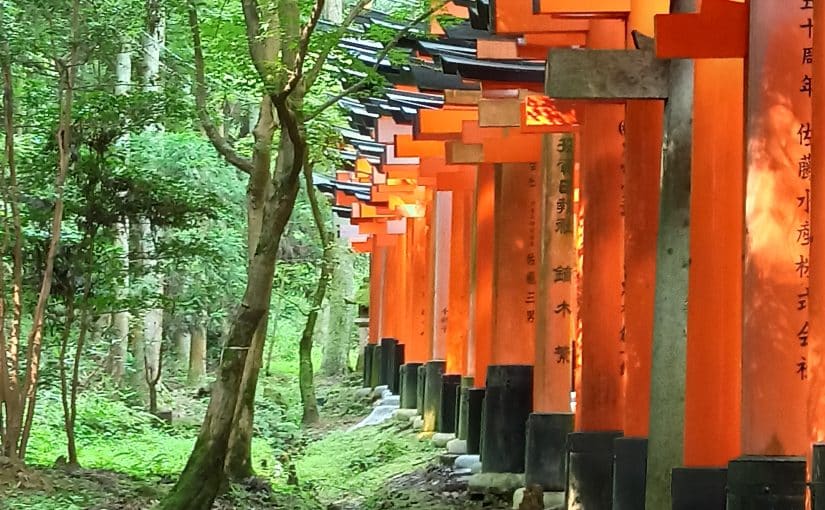Well I can fully believe there are at least 1000 Torii gates here.
As early (yawn… 5am) as we started, there were already people here. We got very excited when we first arrived at the gates thinking there were only a couple paths with them, and we would need to fight for space or wait for a clear stretch. We snapped loads of photos trying to get good shots before people came around the next corner.
But we needn’t have worried. The whole hillside is covered in paths through the forest, and the gates create an almost unbreaking tunnel leading you on. We spent about 2 hours walking up paths and steps leading to the top and nearly the whole way it was covered with Tori gates. Scrolling thru our phone’s photo gallery there is a huge section of distinctly orange images. I’m not going to bombard you with them all, but these are a selection of the best:




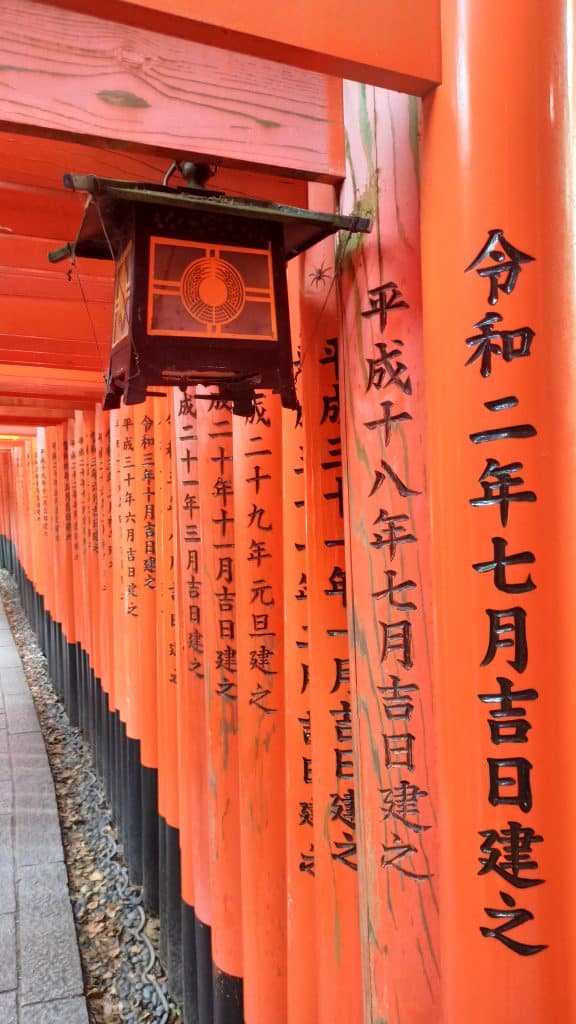


There are several locations on the way up where a bunch of shrines have been dedicated. Each shrine is a small area, usually raised on a stone pedestal, with a central inscribed stone tablet or stone house pagoda sanctuary and a candle house next to it. Some have sculptures of foxes flanking the entrance. These shrines usually have a stone Torii gate at the entrance and lots of mini Torii gates growing all over them from offerings and dedications from people. They are miniature versions of the larger temples.
The reason this hillside is so popular with dedications is that Inari is the principal god of Rice and Agriculture, but also worshipped as the patron of business. Each of the Torii has its date and the name of who dedicated it on the back (the uphill side). We translated a few and found lots of companies had donated them, presumably in pursuit of the favour of the gods.

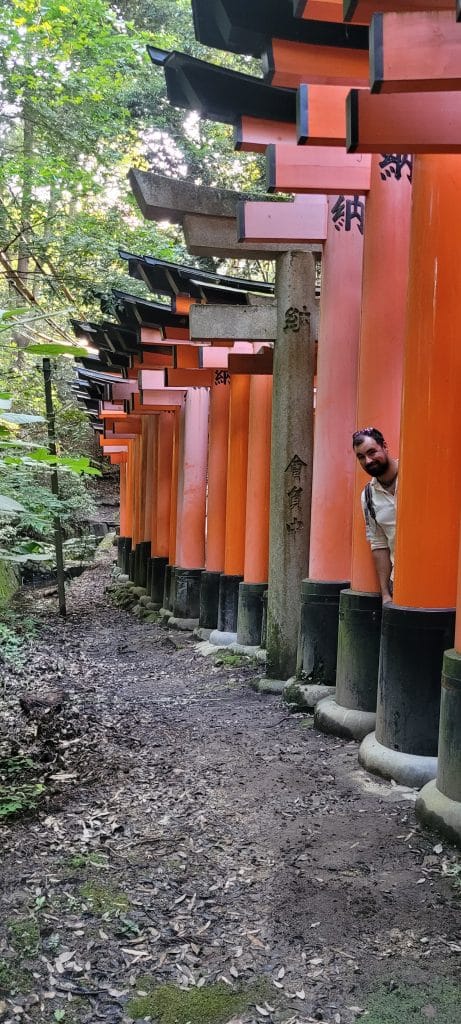



We were early and it was much cooler, aiding our climb to the top of the mountain, also called Inari. But still we arrived absolutely dripping with sweat. I don’t know how you’d do it in the heat of the day. From near the top, the trees thinned for a moment and the Torii gates paused to allow a view out over Kyoto. The landscape here looks to be dead flat for the majority of the city. Then it rises sharply and steeply when it reaches the mountains at its edge. We were looking down into a valley surrounded on 3 sides with mountains and at its mouth, Osaka and then the sea.
On the way down we had to take our time. It wasnt yet 9am and nowhere was open. We waited outside Vermilion cafe, listening to some very excitable americans gabble away. It was worth the wait as the coffe and the food was excellent. Made even more so by a tiered seating area out back, shaded by trees that overlooked a pond. As we ate second breakfast, we could see turtles bubbling around in the murky paddy field water.



We wandered around the main temple at the bottom of the hill for a while, got Aimi a couple tshirts and me a keyring and then headed off. It was hot now. Just standing on the train station platform was sweaty work. But relief came in the form of the air conditioned train that took us back to Kyoto central station.
This is a huge building. Arriving in Kyoto yesterday, we got a train to our house here on platform 33. Its also an… interesting… building, architecturally speaking. As most train stations house long thin trains, this is a long thin building. But down its centre (?) there is a chasm which rises in a slope of steps and escalators to each end, all the way to the roof. Covering this chasm is a huge, asymmetric arched metal frame roof. There are 2 Heli pads on the roof, a garden and a gangway running the whole length, with viewing points of Kyoto Tower opposite. Not only a station, but it also houses a shopping centre, a hotel, numerous eateries, function spaces and pieces of art and sculpture. This building has won all sorts of awards, being designed by Hiroshi Hara. I’ll let you read his design concept below before giving you my impressions.

Aimi had broken her sunglasses today, which were cheap and lasted way longer than could have been reasonably expected. So we started our search here for a replacement pair. We wandered around the station for a while, just trying to work out how to reach the shopping centre. Then, once found, it was clear that we must be in the expensive part. Very few people here and lots of designer names meant the sunglasses we did find were remortgage-the-house expensive.
But we continued climbing the sequential escalators up to the roof level and found the garden. This was quite nice, if very bright without sunglasses, and afforded a free view over the city, now we are standing at it’s center. Up here you could look down into the chasm, or valley, as it was designed to be. It certainly is an impresisve structure, but pretty brutal and unsymmetrical. We walked along the viewing gantry which was quite cool which took us from one end, all the way to the other, high above the valley floor. It then ended with no venue, like bar or restaurant, and just gave us 2 REALLY long escalators back to… ground level?
It wasn’t ground level, but could have been an open courtyard in the middle of a group of high-rises. It was very confusing to navigate. We worked out we needed to go from the south to the north side of the tracks, but for the life of us we couldn’t work it out. There was just no clear way through and we ended up underground in a food and clothing market with no idea how to make progress.
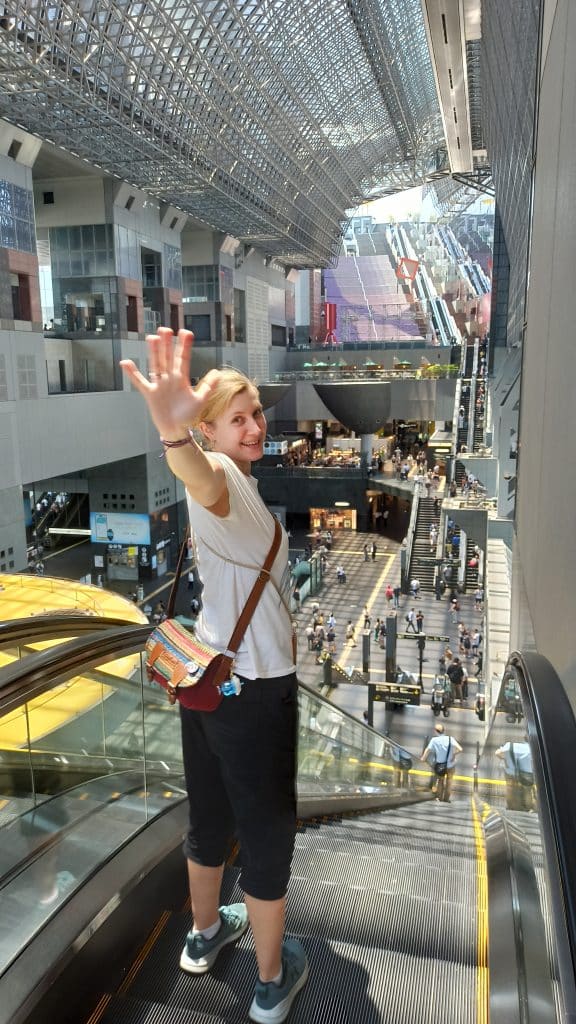








In the end, we did find our way to the north side and decided to have a doughnut break before lack of sugar and patience broke us. I can’t understand how this building is a good design. Its clearly an interesting design, even technically exciting with the huge roof spanning such a large space. But in my (clearly expert) opinion, a building, or anything for that matter, has to fulfill its primary function with absolute competency before aesthetics and style can be added. There can be some negotiation where for the sake of form, the function might need to be slightly inconvenienced. I’m not angling for boring square boxes everywhere because they are efficient and easilnumbered… But function must come first, especially for public infrastructure like train stations where foriegn tourists and people new to the city will be arriving with no experience about how to navigate such a complex place. We literally spent 2 hours here wandering around, and found some cool stuff like a big stone sculpture, a lego model of the building, the skyway, the roof garden and a water fountain that drew pictures in the air. But its was intensely frustrating to find our way around and achieve the objective of buying a simple pair of sunglasses.
In the end we found some in a separate shopping centre across the road. So I’d conclude that, if all the grandeur and design was to keep us there longer and spend more, it worked on the former, but failed the latter. It seemed to be a collection of ideas and structures all piled into one building. It was chaotic and unclear how to reach different areas you could see from across the “valley”. And the “valley”; while an interesting design concept, its a huge use of space that was completely unoccupied and commercially useless. There were a couple terraces that had restaurants or bars, but most were empty and then the upper 6 or so floors just had lots of steps till the buildings roof was reached. It was desserted up at this level with only a few people on route somewhere else. such waste… Personally I dont reallly like it, no matter what awards its won.

Architectural critique (read: rant) aside, you’ll be getting 2 for 1 in this blog. We decided, having gotten up so early, to return home for a mid day siesta and then venture out again in the evening.
This evening we are headed out to a foody place called Pontocho Alley. It runs parrallel to the river and is reputedly the most Kyoto-y part of Kyoto. This is because of its tiny streets with tiny shops all with their own tiny food. Everything seems to be thinly sliced and delicately presented, and hidden away behind slatted wooden shutters for privacy. There are menu stands outsife most shops and most of them display a “sold out” or “fully booked” sign, so its got to be good. Unfortunately this meant we couldn’t eat here, but with a quick google, we found another Zanmai sushi restaurant very close by. This suits me, I love sushi and being a chain all over Japan, its not tourist gouging either. It was a little different to the high tech Tokyo place. At this one we had to use some sort of ancient writing impliment called a “biro” on a delicately thin slip of what is known as “paper”… Weird!
After eating less than we wanted but more than we needed, we walked over the bridge to Gion Corner. This is the main area around which 4 of the 5 Geisha districts meet in Kyoto. Its meant to be the best place to spot them going about their business, but it was a bit late for that now. Instead we walked up to another temple. This one is the Yasaka Shrine having been located here for over 1300 years. It’s very famous, and has patronage of the Emporer. This shrine has been ever since the Emporer of the time asked the monks for a Shinto ritual to appease vengeful spirits believed to be the cause of an epidemic. It soon became practiced yearly and has done since the year 869.
Unfortunately for us, this happens to be occouring on 17th July, just 5 days after we leave Japan. This is something I think we might try to see on a return visit as its meant to be the most famous of Japanese festivals, encorpoating huge floats elaborately decorated along themes. They are located all over the city, are up to 25 meters tall, weigh up to 12 tons, and are pulled on wheels as big as people, so its quite a spectacle we will be missing, ah well. We’ve had to come to accept that we cannot see EVERYTHING while we are here, there is just so much. We just need to go and see what we like the best and then make notes about what to do next time.


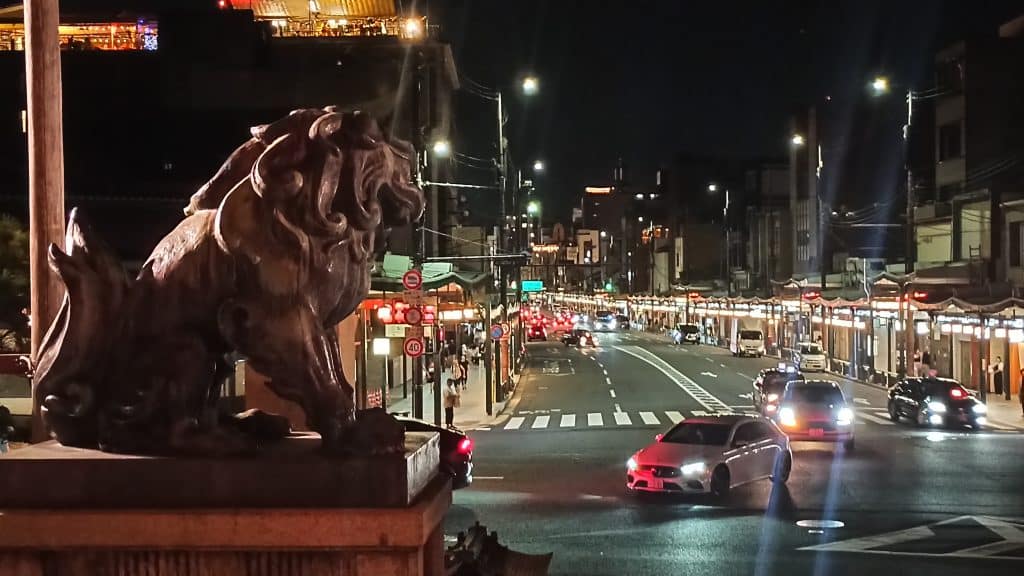






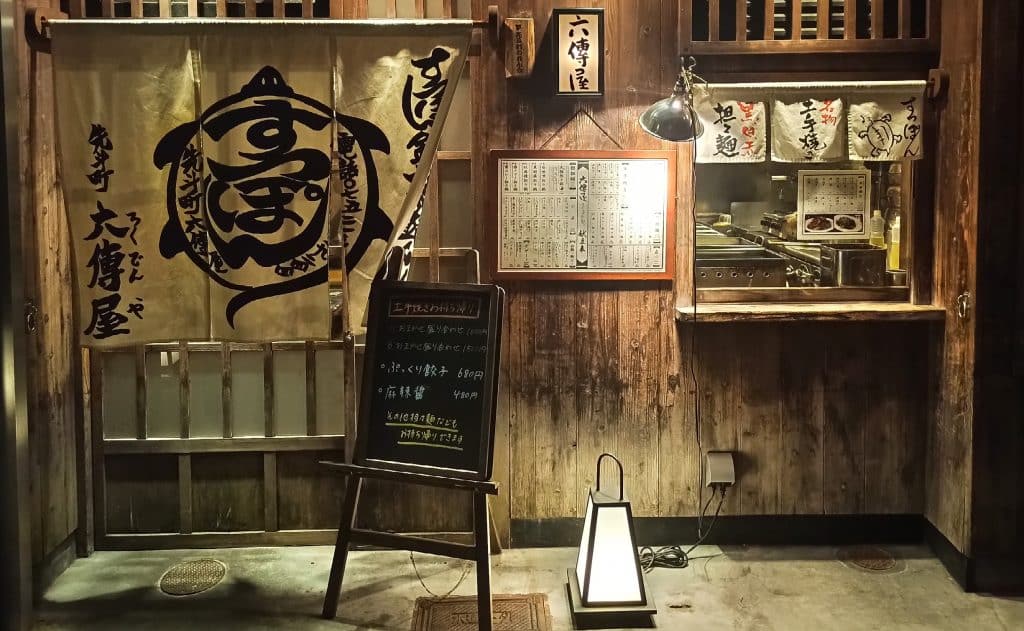
Behind the Yasaka Shrine is Maruyama Park. This has been a formal gardens since the Edo period, altho not fully maintained for that long. Its undergoing a slow restoration but still amazingly nice to wander though. On a shallow hill, it has a long rocky riverbed winding its way down to a murky pond at its end. Its got beautiful small stone bridges and stepping stones in amongst wonderfully kept trees and bushes. I can imagine, when flowing, it makes a calm bubbling sound bouncing off all the rocks. This feature used to be fed by a canal from a natural river, but this has been lost to time, so it mist be pumped now. Alas is was not flowing while we wandered. It was a nice and quite way to finish the night, away from the crowds. Feet aching we made our way home to enjoy a long sleep and lay in tomorrow.
